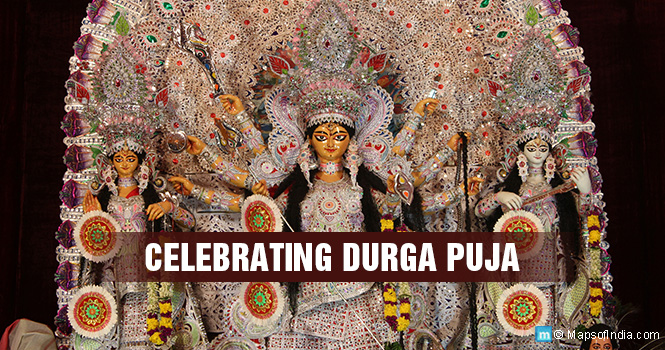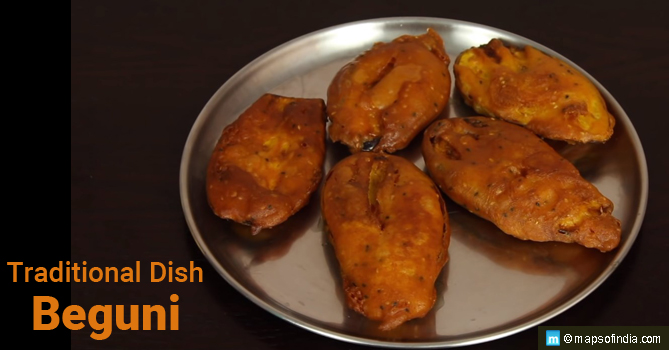
If you have ever been to Kolkata during the time of Durga Puja you would have realised why it is regarded as the city of joy. All over India celebrations are held on a large scale. In fact, the whole state of West Bengal lights up to celebrate the festival. While other east Indian states do celebrate the victory of the Goddess Durga over Mahisasura, Bengal treats the occasion differently. The Goddess is the prodigal daughter, returning to stay at her parental home for 10 days. She is treated with the love and warmth that is due to a daughter. People celebrate to the hilt and the farewell is a teary affair. Here is what makes Durga Puja a very special occasion.
Navratri is celebrated twice a year and coincides with the change in season. The first Navratri of the year falls in the month of March or April and is known as “Chaitra Navratri”. The second Navratri of the year usually falls either in September or October and is called “Sharad Navratri”. The eighth day of Chaitra Navratri is known as “Ashtami” and the ninth day is called “Ram Navmi”.
Mahisasuramardhini on Mahalaya
Since 1931, Mahalaya and the advent of Durga Puja has been marked by the playing of Mahisasuramardhini, a radio programme that combines chants from the Devi Saptasati or the Chandipath and devotional songs rendered by famous Bengali singers and musicians. The holy verses chanted by Birendra Krishna Bhadra cast a spell on Mahalaya morning when this one and half hour programme heralds the onset of Devipaksha or the Navaratri. The drama, the music, and the passion in the programme holds its listeners spell bound. Initially aired by All India Radio, the programme is now broadcast by almost all radio stations and is also available on CD.
Ma Durga’s Vahans
Durga Puja is not complete without the mandatory questions – “Which vahan did Ma arrive by? What is she leaving by?” The belief in Bengal is that Ma Durga is the daughter who comes home from her in-laws’ place for nine nights. The Hindu calendar describes the mounts or vahans by which the Feminine Divine arrives and leaves each year. This is very significant for the Hindus as the mounts or vahans predict the course of the year to come. In 2015, for example, the goddess is believed to have arrived by horse. This foretells of escalating conflict among the countries of the world and political unrest in the country. She shall be leaving by palanquin and this is good news for the farmers as it signifies bumper crop. Some of the other vahans may be boat, elephant, palanquin, buffalo, swan etc.
Puja Parkirama
Pandal parikrama or pandal hopping is the best part of Durga Puja. The entire state is bathed in colours and huge pandals are erected in every locality. Beautifully done up idols of Goddess Durga, Goddess Lakshmi, and Goddess Saraswati alongside Ganesh and Kartik are shown battling the evil forces led by Mahisasura. Themed pandals and color lightings conveying social messages, local fairs, and hundreds of thousands of food and game stalls line the streets of Kolkata and other towns of West Bengal. Cutting across religion, caste, and community lines, men, women, and children dress in new clothes and go visiting the pandals. Pandal parikramas are very common and are part of the puja celebrations.
Dhunuchi Nritya
Dhunuch Nritya or Dhunuch Naach is a major feature of Durga Puja. It is an impassioned dance by young men and women with a flaming dhunuchi in their hands. A dhunuchi is an earthen container with coals and coconut husks used to smoke aromatic herbs. It is a form of worship of the Goddess. The dance to the feisty beats of the Dhaak or drums is a feat that Bengali men and women strive to perfect. The fear of coals falling off the container and burning the dancer’s feet does not deter the dancer. It is love of the Goddess and a cheering crowd that spurs men and women to attempt this feat.
Sindur Khela
Come Dasami, it is time to bid the Goddess farewell. The typical sadness of the end of festivities is broken by the gaiety of Sindur Khela. The Sindur or vermilion is the sign of a married woman. On Bijoya, Ma Durga is treated like a daughter taking leave after a short stay at her parental home. Women dressed in white and red sarees apply the sindur on the idol’s forehead and then smear each other with red powder. It is a celebration of womanhood, of marriage, and a befitting conclusion to the festivities that the Pujas have brought.
The Pujas
• Sashti
Sashti is the first day of Durga Puja and the sixth day of Navratri. Across the state, people gear up to welcome Ma Durga and her entourage to their homes, hearts, and pandals. Till Sasthi, the Durga idol is kept under a veil. With the Kalparambho puja, the veil is lifted and the idol’s face revealed. With the puja called Bodhan, the idol is consecrated and empowered. Then is the traditional Amontron, an invitation to the Goddess to enter the idol, the pandal, and our lives. The Adhibas is the main puja of the day – it is the sanctification of the deity, the pandal, and the pujas in the days to come.
• Saptami
The Navapatrika Snan is the most important puja of Saptami. This puja is done in keeping with the sentiments of the farmers who worship 9 auspicious plants during this season (Sharad, the harvest season in Bengal). Kola (Kela), Kachvi, Asoka, Jayanti, Bilva, Manaka, Dhan, Dadima, Haldi are all tied together and consecrated in holy waters. Together the navapatrika is then dressed as a traditional Bengali woman in a white and red saree. It is also called Kolabou and some think it assumes the role of Ganesha’s wife.
• Ashtami
This is the main Durga puja day. Out come the fineries and the tastiest Bengali dishes. Apart from a Navagriha Puja to placate the 9 stellar objects (including sun and moon), Ashtami is best known for the Anjali. People throng around pandals and pujas to be able to offer flowers to the Goddess and seek her blessings. This is also the day for Kumari Puja when young girls of the community are worshipped in the form of the Goddess. This evening it is time for Sandhi pujan, where 108 lotus buds are used to worship the Goddess. The Sandhi pujan is done through the last minutes of Maha ashtami and the first few minutes of Maha Navami when the goddess transforms from Durga to Chamunda.
• Navami
Navami is the concluding day of the Durga puja. The day is reserved for an austere homam or havan. Compared to the other days, the festivities are muted on Navami and people tend to pray, meditate, and chant for long hours. The bhog prasad on this day is simple but delectable.
• Vijay Dashami/Bijoya
The day of victory, of the Goddess destroying all evil forces is again celebrated with much pomp and splendor. “Shubo Bijoya” is the greeting of the day. On Bijoya, before taking leave of the Goddess, the Aparajita puja is performed. The goddess is worshipped as Aparajita – the undefeated. This puja is said to bring success to all our endeavors.
It is now time to bid a sad and teary farewell to the Goddess. Blessings are sought from the Goddess and all elders and the Visarjan or immersion of the idol is undertaken at a nearby river or lake.
Related Links:
About Durga Puja Celebration in India
Durga Puja Special: Top Maa Durga Songs from Bollywood





